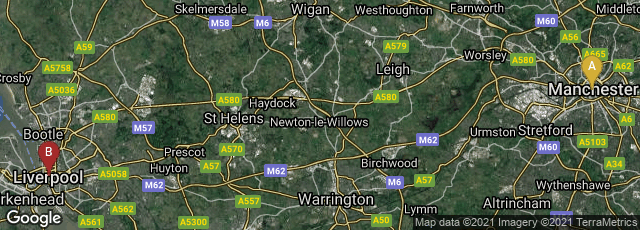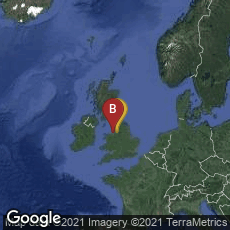

A: Manchester, England, United Kingdom, B: Liverpool, England, United Kingdom
Building the Liverpool and Manchester Railway (L&MR) began on May 24, 1823, to connect the port city of Liverpool with the inland factory city of Manchester. The line finally opened after seven years of development on September 15, 1830. It faced numerous technical hurdles, including the development of
"Wapping Tunnel beneath Liverpool from the south end of Liverpool Docks to Edge Hill. This was the world's first tunnel to be bored under a metropolis. Following this was a 2-mile (3.2 km)-long-cutting up to 70 feet (21.3 m) deep through rock at Olive Mount, and a nine arch viaduct (each arch of 50 feet (15.2 m) span), over the Sankey Brook valley, around 70 feet (21.3 m) high. Not least was the famous 4.75 miles (7.6 km) crossing of Chat Moss" Besides this 64 bridges and viaducts needed to be constructed.
"It was the first railway to rely exclusively on locomotives driven by steam power, with no horse-drawn traffic permitted at any time; the first to be entirely double track throughout its length; the first to have a signalling system; the first to be fully timetabled; and the first to carry mail.[4] John B. Jervis of the Delaware and Hudson Railway some years later wrote: "It must be regarded ... as opening the epoch of railways which has revolutionised the social and commercial intercourse of the civilized world".[5]
"Trains were hauled by company steam locomotives between the two towns, though private wagons and carriages were allowed. Cable haulage of freight trains was down the steeply-graded 1.26-mile (2.03 km) Wapping Tunnel to Liverpool Docks from Edge Hill junction. The railway was primarily built to provide faster transport of raw materials, finished goods and passengers between the Port of Liverpool and mills in Manchester and surrounding towns....
"Within a few weeks of opening it ran its first excursion trains, carried the first railway mails in the world, and was conveying road-rail containers for Pickfords; by the summer of 1831 it was carrying tens of thousands by special trains to Newton Races.
"Although the Act had allowed for it to be used by private carriers paying a toll, from the start the company decided to own and operate the trains itself. Although the original intention had been to carry goods, the canal companies reduced their prices, (an indication that, perhaps the railwaymen had been right to suggest their charges were excessive) and the extra transit time was acceptable in most cases. In fact the line did not start carrying goods until December, when the first of some more powerful engines, Planet, was delivered.
"What was not expected was the line's success in carrying passengers. The experience at Rainhill had shown that unprecedented speed could be achieved. The train was also cheaper and more comfortable than travel by road. So, at first, the company concentrated on this, a decision that had repercussions across the country and triggered the "railway mania".
"Initially trains travelled at 17 miles per hour (27 km/h), due the limitations of the track. Drivers could, and did, travel more quickly, but they would be reprimanded: it was found that excessive speeds could force apart the light rails, which were set onto individual stone blocks without cross-ties...."(Wikipedia article on Liverpool and Manchester Railway, accessed 11-11-2018).
Around 1837 Arthur Freeling of Liverpool published his pocket companion to the L&MR entitled The Liverpool and Manchester Railway Companion, and Guide to Both Towns. This described every detail on the 30 mile journey by the half-mile. As a frontispiece the work included a long lithographed panoramic style view of a "First Class Train" below which is is a "Second Class Train" Followed by a "Train for Cattle and Goods." This image shows in particular that the first enclosed passenger train cars were basically traditional carriages on a frame with iron wheels. Luggage was placed on top of the coaches as in a traditional coach. The enclosed cars were for first class; second class cars were open to the elements with some kind of an awning type roof. Presumably second class passengers kept their luggage with them. At the back of the second class train is a car that holds a regular carriage with its passengers and coachmen. Presumably those passenger would connect with horses at the end of their journey.